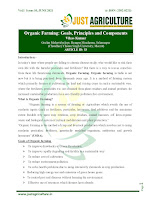What is seed?
Agronomically "A seed, seed material or propagule is the living part of the crop which is used for propagation OR in other words any part of the crop which have the ability to grow as a new crop."
Botanically "Seed is a fertilised ovule consisting of intact embryo, stored food and seed coat which is viable and has the capacity to germinate."
Types of Seeds
International Crop Improvement Association (1946) classified the seeds -
1. Breeder / Nucleus Seed:- such type of seeds are produced directly under the supervision of plant breeder. Such type of seeds have highest genetic value and produced in little quantity. Breeder seed is used to produce the foundation seed. Genetic Purity - 100%
Tag Colour - Yellow 💛
2. Foundation Seed:- Foundation seed is produced from breeder seed and it is the source of all other certified seed classes either directly or through registered seed. Thus, it is also known as mother seed. Foundation seed is produced on government forms experiment stations and agricultural universities under strict supervision of scientist and experts from NSC.
Genetic purity - 99.5%
Tag Colour - White ⚪
3. Registered Seed:- Registered seed is produced from foundation SEED or registered seed itself it is produced by progressive farmer under technical guidance and supervision from SSC. It is often omitted and certified seed is produced directly from foundation seed.
Tag Colour - Purple 💜
4. Certified Seed:- Certified seed is the progeny of registered seed or foundation seed. Is approved and certified by the state seed certifying agency certified seed is available for farmers for commercial crop production.
Genetic purity - 99.0%
Tag Colour - Azar Blue 💙
Other categories of seeds
Roberts (1973) classified the seeds based on their storability and gave terms "ORTHODOX and RECALCITRANT"
1. Orthodox Seeds:- such type of seeds which can remain viable for long time at low temperature and in low moisture content. e.g. Seeds of cereals🌾.
2. Recalcitrant Seeds:- Such type of seeds which don't remain viable for long time at low moisture and low temperature because they so very immediate loss of ability with decrease in moisture content below 12-14%. e.g. Seed of Mango.
3. Source Identified Seed:- Such type of seed or other propagating materials which are collected from naturally growing area, where selection or testing of the parent population hasn't made.
Tag Colour - Orange 🧡
4. Truthfully Labelled Seed:- Such type of seeds produced by private seed companies and sold under truthful labels. This type of seeds does not come under the purview of the Department of Seed Certification. Although, field and seed standard should be maintained as per Seed Act. Truthful labelling is compulsory for notified varieties and it is tested for physical purity and germination %.
Tag Colour - Opal Green 💚
Seed Dormancy
When a viable seed cant germinate even under favourable conditions provided for germination, is called seed dormancy.
Breaking of Seed Dormancy
There are two methods for breaking the seed dormancy -
1. Scarification:- Any type of physical or chemical treatment, which is being used to weaken the seed coat is known as a scarification. e.g. Use of KNO3 and Thiourea.
2. Stratification:- When seeds are kept into the low temperature treatment (Chilling temperature) to break their dormancy is called stratification. e.g. Seeds kept at 2-8°C for 12-24 hours..
Seed Act
The seed Act was enacted by the parliament on 29 December 1966.
This act came into force from the country on 2nd October 1969.
Seed was declared as an essential commodity under the essential commodities act 1955.
Note:- All the pictures included in the blog have been taken from the various internet sources. All the right of the pictures are reserved to their owners. Pictures are only used here for the fair use of content for educatioal purpose.
Thank You
Vikas Kashyap:)
Contact US
















0 Comments